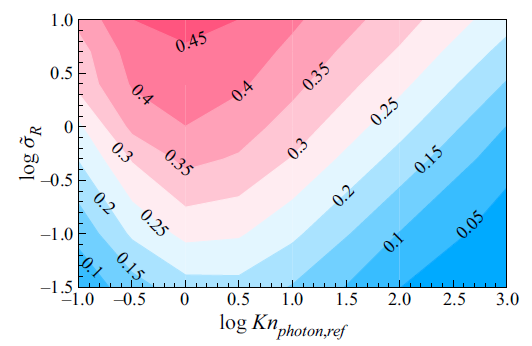The non-equilibrium dynamics of molecular (diatomic/polyatomic) gas is commonly encountered in aerospace engineering. For example, at a high Mach number, the air surrounding an aircraft decelerates and heats up rapidly after compression by shock waves, which causes a strong conversion from the translational energy into the internal energy (i.e., rotational, vibrational, and electronic energies). The temperature may reach thousands of degrees Kelvin and leads to significant changes in the physical and chemical properties of the gas. Meanwhile, the thermal radiation, which is induced by transitions between excited states of gas molecules, significantly contributes to the overall heat load on hypersonic aircraft. Therefore, accurate predictions of molecular gas flow and radiative energy transfer are essential for developing thermal protection systems for aircraft entering planetary atmospheres.
Previous modelling methods use either macroscopic equations with proper boundary conditions, which are only applicable to near-equilibrium flows, or the direct simulation Monte Carlo (DSMC) method, which is inadequate for radiative molecular gas flows and computationally unaffordable in the near-equilibrium regime. Therefore, tractable kinetic model equations incorporating radiative heat transfer are highly desirable and urgently needed.

Associate Professor Lei Wu’s research group from the Department of Mechanics and Aerospace Engineering at the Southern University of Science and Technology (SUSTech) has recently made important progress in this problem. Their paper, entitled “Kinetic modelling of rarefied gas flows with radiation”, has been published in the Journal of Fluid Mechanics.
In this work, two kinetic models are proposed for high-temperature gas flows with internal degrees of freedom and radiation. One of the models uses the Boltzmann collision operator to model the translational motion of gas molecules, which has the ability to capture the influence of intermolecular potentials. At the same time, the other adopts the relaxation time approximations, which has higher computational efficiency. In the proposed kinetic model equations, not only the transport coefficients but also their underlying relaxation processes are recovered. The non-equilibrium dynamics of gas flow and radiation are tightly coupled, where the transport properties of gas molecules and photons are correlatively dependent.

Figure 1. The heat fluxes from convection (blue lines) and radiation (red lines) along the cylinder surface in radiative hypersonic flows

Figure 2. The ratio of radiative heat flux to the total heat flux on the surface of the cylinder in hypersonic gas flow with the variation of photon Knudsen number and relative radiation strength
The accuracy of the proposed models has been assessed by comparing them with DSMC simulations and experimental data for non-radiative nitrogen gas flows. Then, the study on the effect of radiation was conducted by solving the kinetic models in two-dimensional radiative hypersonic flow passing a cylinder. It is found that the presence of radiation can double the heat load on the obstacle surface compared with that with convective heat transfer only. Additionally, it is found that the radiation makes a profound contribution to the total heat transfer in radiative hypersonic flow at an intermediate photon Knudsen number.

Figure 3. 3D kinetic modelling of a re-entry capsule in hypersonic radiative gas flow using the general synthetic iterative scheme
Research Asst. Prof. Qi Li in Prof. Lei Wu’s group is the first author of this paper. Ph.D. students Zeng Jianan and Huang Zemin are collaborative authors, and Prof. Wu is the corresponding author. SUSTech is the only affiliation of the paper. This study was supported by the National Natural Science Foundation of China (NSFC).
Prof. Wu’s group focuses on the multiscale kinetic modelling of rarefied gas flows, with applications in high-altitude aerothermodynamics of space vehicles, microelectromechanical systems, etc. Remarkable progress has been achieved in recent years, e.g., the Wu model was recognized in the community of rarefied gas dynamics, and the developed multiscale numerical method, the general synthetic iterative scheme, has been applied in industry. Their research aims at developing multiscale kinetic modelling of rarefied gas flows with complex physical and chemical processes, which can be used to solve problems, such as hypersonic gas flow with real gas effects, multibody separation of aircraft, radiative flows in inertial confinement fusion and EUV lithography, etc.
Paper link: https://doi.org/10.1017/jfm.2023.400
To read all stories about SUSTech science, subscribe to the monthly SUSTech Newsletter.
Proofread ByAdrian Cremin, Yingying XIA
Photo By